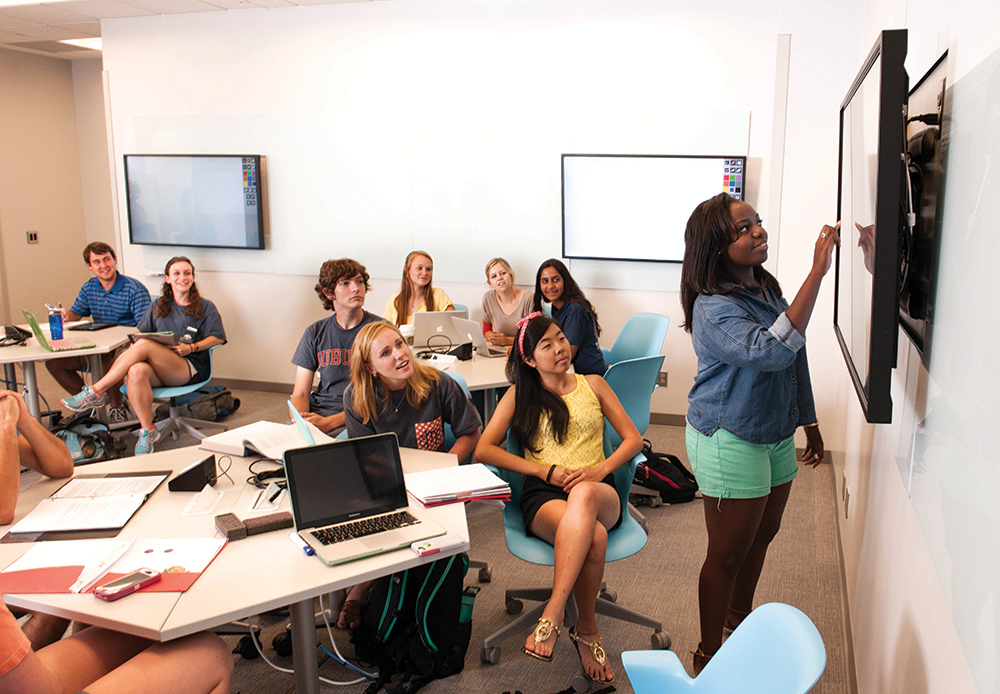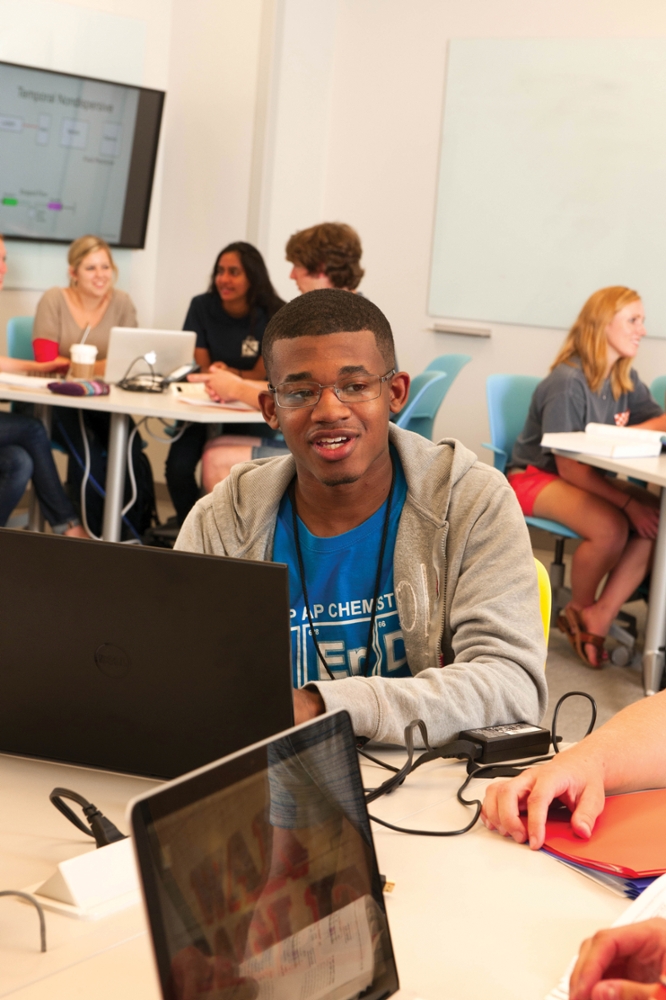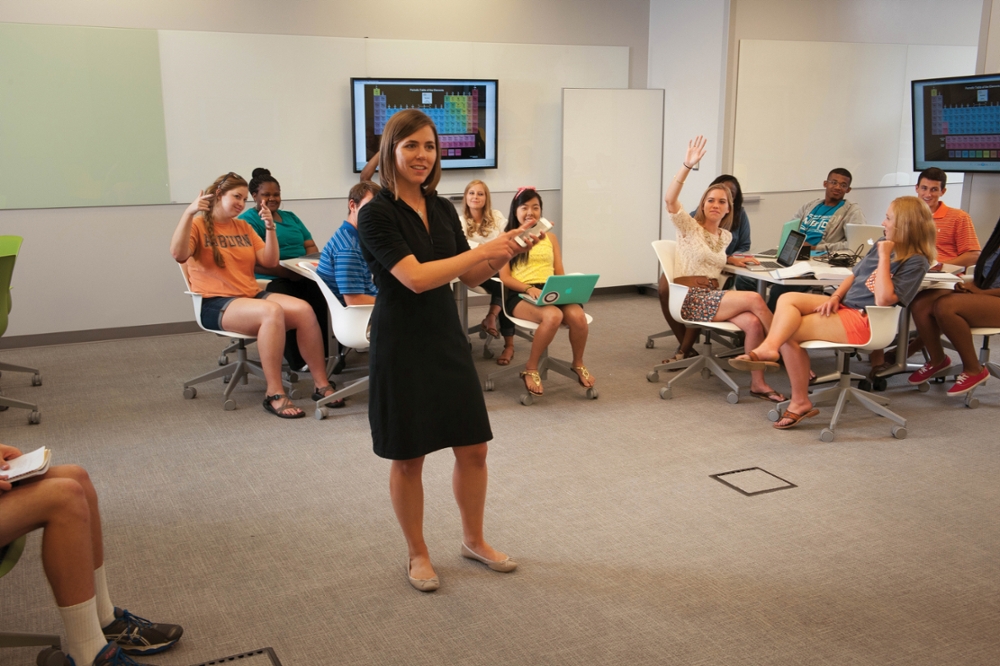Flipping the Classroom: A new way to teach
Auburn University's College of Sciences and Mathematics is "flipping the classroom" as part of an innovative way to teach Auburn students through a newly constructed Engaged in Active Student Learning, or EASL, classroom. Working with the Office of the Provost, the college is leading Auburn's effort on the unusual design since all Auburn students must take core classes in the college prior to graduating.
"In contrast to traditional classrooms where faculty teach 'at' students, often in stadium-style rooms, this room was designed to encourage teacher-student interactions, and student-student collaborations, two aspects which are known to lead to improved learning outcomes," said COSAM Dean Nicholas Giordano. "COSAM faculty spent many months preparing to use the EASL classroom as effectively as possible in their teaching, and the new space was ready to use at the beginning of the fall 2014 semester."
The new EASL classroom is a student-centered space featuring table clusters that will seat six students each. Each cluster has its own glass board for writing and sharing ideas, as well as a monitor so students can connect their electronic devices and make use of web-based resources during the learning process.
The brain behind the EASL classroom concept at Auburn is Wiebke Kuhn, information technology manager for the College of Liberal Arts. Kuhn, who was previously an instructor in Auburn's Department of English, drew from her own experience in the classroom, as well as her technical expertise, to bring the EASL classroom concept to the university.
"I had been following the research on these types of classrooms around the country and they had proven to be very successful, so I approached the provost a couple of years ago requesting to initiate these kinds of classrooms at Auburn," said Kuhn. "The first classroom in Haley Center has proven to be very successful, so the provost financed the construction of another, similar space in the Sciences Center Classrooms Building."
The EASL classrooms are often referred to as "flipped classrooms" due to a non-traditional, or inverse teaching method that is applied in the space.
"The term 'flipped classroom' means we flip what happens in the classroom and what happens at home," said Kuhn. "In a traditional lecture setting, a student will come to class and get talked at for 75 minutes, and will not have a whole lot of interaction with fellow students or with the professor. The student will then go home and practice what he or she has learned.
"The EASL classroom allows us to flip this model on its head. Instead of lecturing in class, a faculty member might record the lecture on a video and provide it before the class meets. Then students will apply the learning they did on their own in groups in the classroom. The professor may talk about the principles and give some examples before class, and then in class students do activities, conduct experiments, and/or have discussions, so they can apply the knowledge in the classroom and the faculty member can gauge how well they are learning. Teaching students how to learn on their own and in groups will help them down the line, as will using advanced technologies in new ways. The classroom also teaches students how to communicate and how to become leaders."
Kuhn provided workshops for COSAM faculty so those who are using the new EASL classroom would be better prepared to meet the challenges that come with employing new teaching methods, including managing student expectations.
"Dealing with student expectations is very important because students think when they sign up for a class they are signing up for a lecture," explained Kuhn. "All of a sudden they discover they have to do something in class rather than sit and listen. If the faculty member is aware of student expectations and how to address them immediately, it lets students know what the faculty member expects on day one, then the class is more successful."
Kuhn also offered tips on how to incorporate group work into the classroom, the best ways to successfully implement the flipped-classroom model, and how to assess whether the new approach is successful.
Sharon Roberts, associate professor in the Department of Biological Sciences, is one of the COSAM faculty members who used the new classroom last fall. She taught a freshman Learning Community called, "Disease Hunters," and this semester, she is teaching virology. Roberts was involved on the planning committee for the original EASL classroom in Haley Center.
"One of the problems with collaborative work in a traditional classroom is everyone is facing forward, in a row, which makes it hard to work together. I actually had students sitting on the floor wherever they could find space, as well as standing up to work with students in the row behind them when I used collaborative work in a traditional classroom," said Roberts. "Now, with this new EASL classroom, we have created a physical space for groups to work together and talk to one another. In fact, the physical environment actually promotes interaction."
"I had been flipping the classroom in immunology and virology without the technological support of an EASL classroom, but now that I have the opportunity to teach virology in EASL, I can really appreciate the way technology facilitates students sharing their work and ideas with one another. It also gives everyone access to the best technology, which not only levels the playing field but allows me to more fully take advantage of the technology knowing everyone has access."
Working behind the scenes on COSAM's behalf to ensure the new EASL classroom came to fruition was Vince Cammarata, COSAM's associate dean for academic affairs. He was first charged with locating a space for the classroom's construction. He then worked to ensure COSAM faculty would take full advantage of the new classroom by recruiting professors to teach in the space. Cammarata calls the new EASL classroom a "grand experiment" in learning.
"What happens when you give the students the Internet to go and learn from, and whatever resources they find, they can go ahead and use them? Can they Google? Do they understand the limitations of Wikipedia? Can they find authentic information that's trustworthy? That's not something you can learn in a lecture when someone else has already cultivated the material," said Cammarata.
The EASL classrooms in Haley Center and Sciences Center Classrooms Building are serving as prototypes for future classroom buildings constructed on Auburn's campus, such as the one slated to eventually replace Parker Hall.
"Like I said, it's a grand experiment, and like any experiment, it will have some growing pains," said Cammarata. "The beginning might not be all that smooth, but eventually, people will figure it out and in the long term, it will work out. Now we have to figure out how to properly assess whether the classroom works. Do the students learn better? Are they truly engaged more? Do they like it? Do they get more out of it? That's the next step in this process that ultimately places COSAM at the cutting edge of teaching techniques and technology."
Latest Headlines
-
02/12/2025
-
02/11/2025
-
02/10/2025
-
01/30/2025
-
12/03/2024




